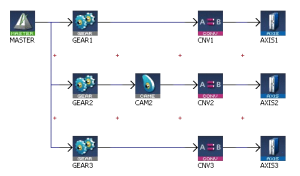Pipe Network Editor
Figure 5-38: Pipe Network Structure
Functions of the Pipe Network Editor are accessed via context sensitive menus.
When the Pipe Network Editor is used, an ST![]() "Structured text"
A high-level language that is block structured and syntactically resembles Pascal file containing all the calls to the Motion / Pipe Network Library is automatically generated during compilation, and based on the graphical description of the Pipe Network.
"Structured text"
A high-level language that is block structured and syntactically resembles Pascal file containing all the calls to the Motion / Pipe Network Library is automatically generated during compilation, and based on the graphical description of the Pipe Network.
Although strongly recommended, the Pipe Network Editor is optional.
Use it to graphically create a Pipe Network or to manually instantiate Pipe and Pipe Blocks by calling the appropriate functions in the Pipe Library directly from the IEC![]() "International Electrotechnical Commission"
IEC is a not-for-profit, non-governmental international standards organization that prepares and publishes International Standards for all electrical, electronic and related technologies 61131-3 editors (SFC
"International Electrotechnical Commission"
IEC is a not-for-profit, non-governmental international standards organization that prepares and publishes International Standards for all electrical, electronic and related technologies 61131-3 editors (SFC![]() "Sequential Function Chart"
It can be used to program processes that can be split into steps.
The main components of SFC are:
- Steps with associated actions
- Transitions with associated logic conditions
- Directed links between steps and transitions, FBD
"Sequential Function Chart"
It can be used to program processes that can be split into steps.
The main components of SFC are:
- Steps with associated actions
- Transitions with associated logic conditions
- Directed links between steps and transitions, FBD![]() "Function Block Diagram"
A function block diagram describes a function between input variables and output variables. A function is described as a set of elementary blocks, ST, IL
"Function Block Diagram"
A function block diagram describes a function between input variables and output variables. A function is described as a set of elementary blocks, ST, IL![]() "Instruction List"
This is a low-level language and resembles assembly, FFLD
"Instruction List"
This is a low-level language and resembles assembly, FFLD![]() "Free Form Ladder Diagram").
"Free Form Ladder Diagram").
See Programming Languages for more information.
Grid
The layout of the editor is grid oriented, which means that items (except the comments) are placed in the middle of a rectangular area called a grid unit.
-
-
Comments are not centered in the grid unit but merely placed at the cursor position.







